#leafcutter bee photographs
Text
Strange Bedfellows: these unprecedented photos show a leafcutter bee sharing its nest with a wolfspider

I stumbled across these photos while I was looking up information on leafcutter bees, and I just thought that this was too cool not to share. Captured by an amateur photographer named Laurence Sanders, the photos were taken in Queensland, Australia, several years ago, and they've garnered the attention of various entomologists and arachnologists around the world.

The leafcutter bee (Megachile macularis) can be seen fetching freshly-cut leaves, which she uses to line the inner walls of her nest. The wolfspider moves aside as the bee approaches, allowing her to enter the nest, and then simply watches as the leaf is positioned along the inner wall.
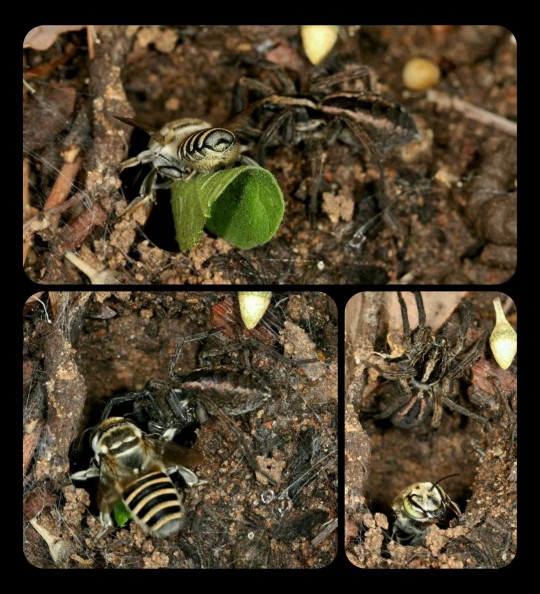
Once the leaf is in position, they seem to inspect the nest together, sitting side-by-side in the entryway; the bee then eventually flies off to gather more leaves, while the wolfspider climbs back into the burrow.
The bee seems completely at ease in the presence of the wolfspider, which is normally a voracious predator, and the spider seems equally unfazed by the fact that it shares its burrow with an enormous bee.
The photographer came across this shared burrow unexpectedly, and he then captured the images over the course of about 2 days (these are just a few of the photos that were taken). During that 2-day period, the bee was seen entering the nest with pieces of foliage dozens of times, gradually constructing the walls and brood chambers of its nest, and the spider was clearly occupying the same burrow, but they did not exhibit any signs of aggression toward one another.
The photos have been examined by various entomologists and arachnologists, and those experts seem ubiquitously surprised by the behavior that the images depict. The curator of entomology at Victoria Museum, Dr. Ken Walker, noted that this may be the very first time that this behavior has ever been documented, while Dr. Robert Raven, an arachnid expert at the Queensland Museum, described it as a "bizarre" situation.
This arrangement is completely unheard of, and the images are a fascinating sight to behold.
Sources & More Info:
Brisbane Times: The Odd Couple: keen eye spies bee and spider bedfellows in 'world-first'
iNaturalist: Megachile macularis
#entomology#arachnology#leafcutter bee#wolfspider#symbiosis#cool animals#cool bugs#bees#spiders#nature#cute#insects#arachnids#australia#props to the photographer#laurence sanders#this is a cute couple#but their babies would be terrifying
21K notes
·
View notes
Text
Black Bees and Yellow Sumac: A Wonderful Fall Combination
Black Bees and Yellow Sumac:A Wonderful Fall Combination shows readers some photos of a carpenter mimic leafcutter bee as it feeds on winged sumac flowers. It goes on the explain how the bees were named and discusses the author/artist’s experiences.
Black Beauty
The winged sumac flowers have come and gone, but they’re not forgotten. Back in September, when they were blooming like crazy, the pollinators were flocking to them. It definitely made for a couple of fun photo sessions out in the woods and also some great color combinations. There’s just something about hundreds of little yellow flowers that looks really stunning with black or…

View On WordPress
#bee photographs#bee photography#bees#black bees#black insects#black leafcutter bees#carpenter mimic leafcutter bees#fall bees#fall insects#Florida bees#Florida insects#Florida leafcutter bees#insect photographs#insect photography#insects#leafcutter bee photographs#leafcutter bees#macro photographs#macro photography#photography
1 note
·
View note
Text

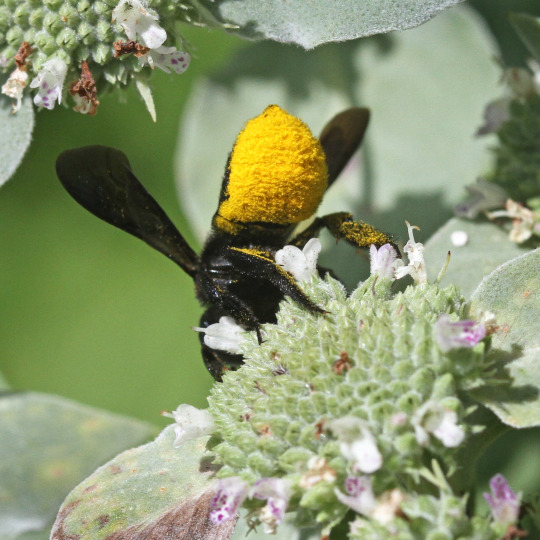


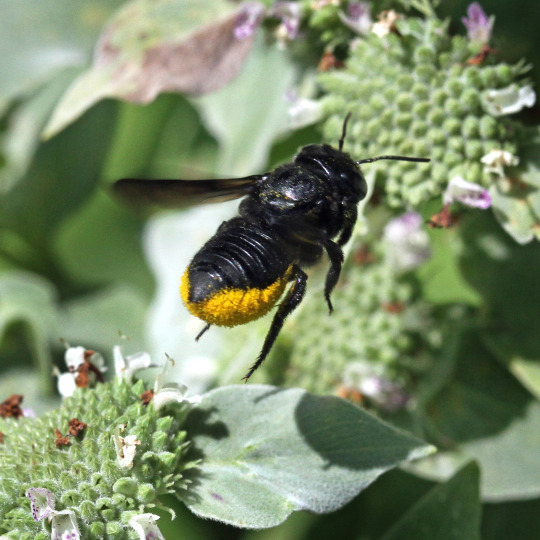
So. Much. Pollen.
Carpenter-mimic Leafcutter Bee (Megachile xylocopoides)
August 16, 2023
Southeastern Pennsylvania
#Megachilid Monday#bee#bees#photographers on tumblr#Carpenter-mimic Leafcutter Bee#bugs#bug#bugblr#entomology#insects#insect#hymenoptera#animals#nature#Megachilid
884 notes
·
View notes
Text
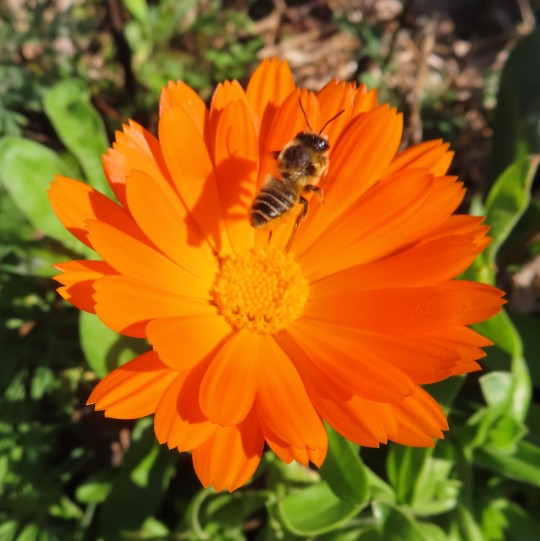
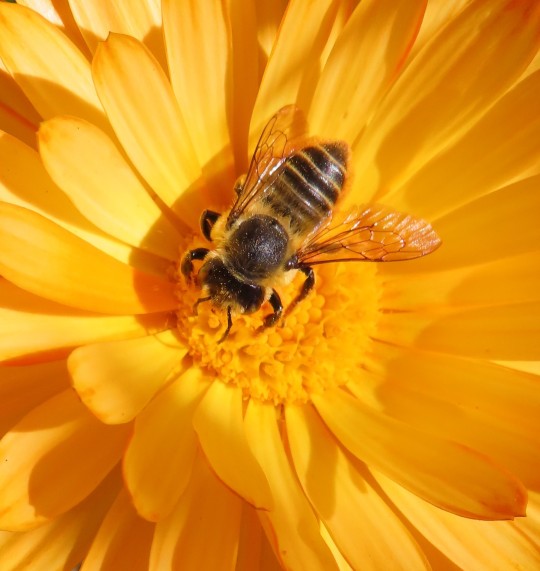
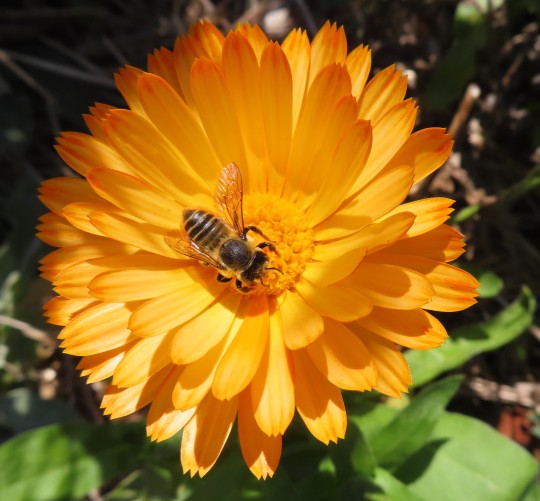

Calendula officinalis (pot marigold) and Megachilidae (leafcutter bee)
Pot marigolds are originally from Southern Europe and they've been cultivated for thousands of years, not only as a pretty flower but also as a medicinal herb. Marigolds were used extensively in ancient Roman, Greek, Middle Eastern and Indian cuisines and extracts were also used in dyes and cosmetics. The 'pot' in pot marigold refers to a cooking pot.
Leafcutter bees can be a little hard to identify from the top but if they stick their abdomen up in the air (photo 4) you can see the specialized hairs called scopa which they use to store pollen. If these bees start chewing holes in you garden plants, insecticides won't do any good. Leafcutter bees don't eat leaves - they use them as building material for their ground nests. Like any self-respecting bee, leafcutter bees go straight for the nectar and pollen, and show absolutely zero interest in the salad menu.
#flowers#photographers on tumblr#marigold#calendula#leafcutter bee#fleurs#flores#fiori#blumen#bloemen#vancouver
126 notes
·
View notes
Text

Willughby’s leafcutter bee (Megachile willughbiella), Staffordshire, England
‘I have a particular interest in the UK’s solitary bees and like to photograph the species that visit our Staffordshire garden. I had seen this male Willughby’s leafcutter bee looking out of a hole, but it kept retreating whenever I approached. They often pause to warm up at the entrance before flying off, so I waited, camera poised for the right moment. It eventually reappeared and I carefully framed the shot. At the last moment it cocked its head to one side to what I felt was a pleasing angle’
Photograph: Ed Phillips
British Wildlife Photography Awards
#ed phillips#photographer#british wildlife photography awards#willughby's leafcutter bee#bee#megachile willughbiella#staffordshire#england#macrophotography#insect#nature
50 notes
·
View notes
Text
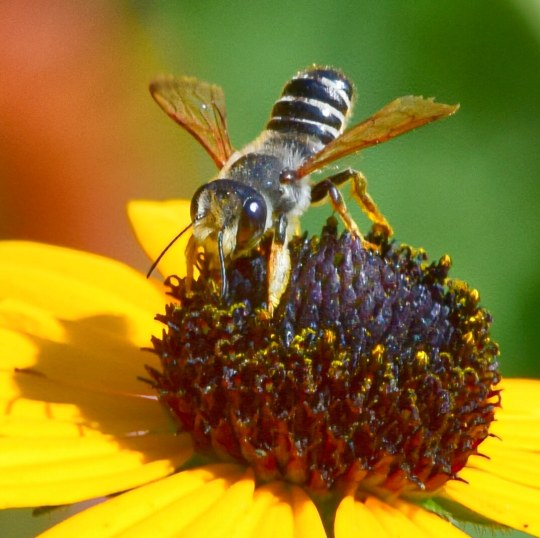
#leafcutter bee#bees#pollinators#nature photography#wildlife photography#photographers on tumblr#original photography
22 notes
·
View notes
Text

The industrious little leafcutter bee, taking resting on a calendula leaf after having cut a disc of leaf from another plant.
It was a hot day in Ireland today and the leafcutter was busy. I'm not sure what plant it was targeting but on each occasion it would fly to a particular corner of the garden and rest on calendula or tomato leaves for approximately one minute before flying off again.
In between cutting leaves of course they are busy collecting pollen from various flowers in the garden.
From Panoramic Ireland
#ireland#plant#leafcutter bee#melittology#photography#vsco#vscocam#irish#photographers on tumblr#nature#entomology#bees#pollinators#bee friendly
25 notes
·
View notes
Text










Touches
IRL Animal Handling or: The Birds and the Bees (and spider and chipmunk)
#wildlife photography#spider#chipmunk#canada goose#goose#leafcutter bee#my photo#nature photography#photography#photographers on tumblr#chickadee
1 note
·
View note
Photo
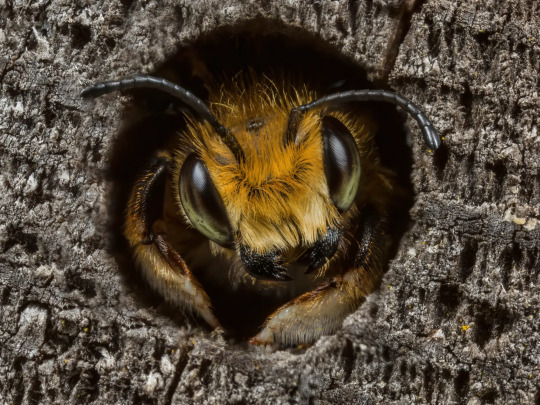
Willughby’s Leafcutter Bee (Megachile willughbiella)
Photograph: Ed Phillips
#England#bee#wildlife#animals#nature#photography#cute#fauna#cute animals#wildlifephotography#peace#peace photography
2K notes
·
View notes
Text

Willughby’s Leafcutter Bee, by Ed Phillips – Animal Portraits runner-up |
Willughby’s leafcutter bee (Megachile willughbiella), Staffordshire, England.
‘I have a particular interest in the UK’s solitary bees and like to photograph the species that visit our Staffordshire garden. I had seen this male Willughby’s leafcutter bee looking out of a hole, but it kept retreating whenever I approached. They often pause to warm up at the entrance before flying off, so I waited, camera poised for the right moment. It eventually reappeared and I carefully framed the shot. At the last moment it cocked its head to one side to what I felt was a pleasing angle’.
Photograph: Ed Phillips/British Wildlife Photography awards 2023 / Courtesy the Guardian #love #solitary #bees 🐝🐝🐝
0 notes
Video
Leafcutter Bee by Brian Moffet
Support your local bees
3 notes
·
View notes
Photo


Flat-tailed leafcutter bee, Megachile mendica, in a Conroe, Texas, Montgomery county, TX, USA
photograph by Paxon Kale CC
44 notes
·
View notes
Text
Fall Pollinators are Coming Out for the Fall Wildflowers
Just a Little Black Bee
The winged sumac (Rhus copallinum), which is definitely a fall wildflower, albeit an early one, was highly attractive to many pollinators while it was in full bloom. Along with the usual summer crowd, I’m beginning to see some of the fall group like this carpenter mimic leafcutter bee (Megachile xylocopoides). Although they can be found in small numbers in the summer, I…

View On WordPress
#bee photographs#bee photography#bees#black bees#black insects#carpenter mimic leafcutter bees#fall bees#fall insects#fall pollinators#Florida bees#Florida insects#Florida pollinators#insect photographs#insect photography#insects#leafcutter bee photographs#leafcutter bees#macro photographs#photography#pollinator photographs
0 notes
Text


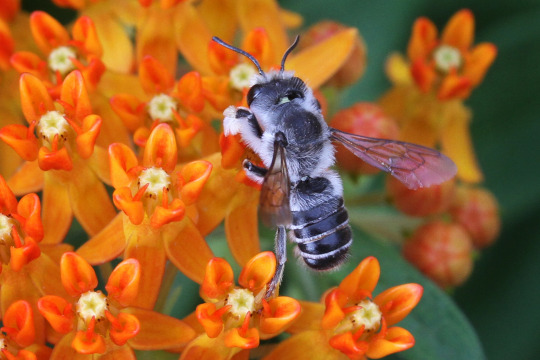


Megachilid Monday
June, 2023
Southeastern Pennsylvania
#stealing the Megachilid Monday idea from @cnestus#Doubt I'll “bee” consistent I just have a lot of leafcutter pics right now#bee#bees#photographers on tumblr#wish I could identify them all#megachilid#leafcutter bees#bugs#bug#bugblr#entomology#insects#insect#beeblr#hymenoptera
539 notes
·
View notes
Text

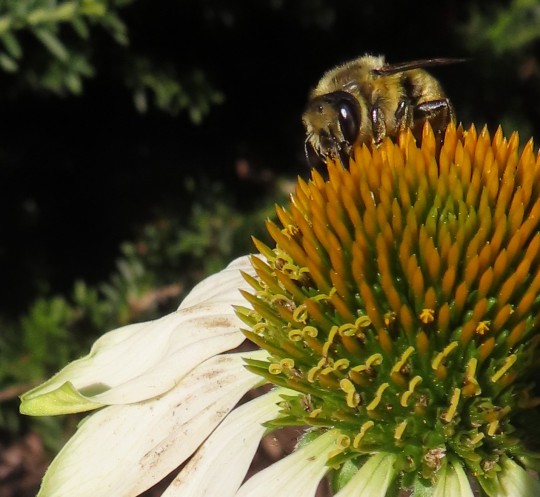

Echinacea (coneflower) and Megachile (leafcutter bee)
Preparations
Obviously, this white coneflower has seen better days but, hey, cut it some slack - it's still pumping out nectar in October. At this time of year, leafcutter bees are looking for food for their kids to get them through the winter. This is a critical time for the adult bees because most of their larvae will spin their cocoons and go into a prepupal state known as diapause.
Diapause involves increasing the concentration of glycerol (anti-freeze) in body tissues which will enable bee prepupae to survive low temperatures. In a few weeks time, all of the adult leafcutter bees will be gone but not before ensuring the survival of the next generation.
Of course, the coneflower is essentially following the same strategy. This Echinacea wants to get pollinated as quickly as possible so it can set its seeds before the first snowflakes arrive.
#flowers#photographers on tumblr#echinacea#leafcutter bee#October#fleurs#flores#fiori#blumen#bloemen#vancouver
110 notes
·
View notes
Photo







Sculptured Resin Bee - Megachile sculpturalis
One more post for the day, and this is one that has been a long time coming. Truthfully, identifying this Bee has been a struggle ever since photographing it 2 years ago because it had little to no matches within Toronto along with Canada. I initially had it pegged as a large species of Andrenid Bee, but with little confidence to that, so I shelved it temporarily until another idea came to mind. Today, the mystery is solved thanks to my work for the inspiration. The last few days there has been a lot of talk of similarity as it relates to my job which got me to apply that to insects too, “What if I try searching for something similar to this Bee to find a match?” Basically, target the problem from a different angle. Sure enough, it all made sense when I looked at the Eastern Carpenter Bee’s page on Bugguide (thank you as well) and found this specie. At last! The similarity is also the reason behind the previous video post as well: got to showcase the both of them. As for why this specie didn’t appear conclusively in a wider search, it turns out this specie of giant Leafcutter Bee (more specifically a Resin Bee) came from Asia and has gradually expanded its North American range.
Fortunately, while invasive it doesn’t seem to be a significant pest and largely keeps to itself, similar to Carpenter Bees and other Leafcutters. Here we find a few foraging at some flowers, some of which are males as indicated by the presence of yellow patches on their face, also similar to Carpenter Bees. I sincerely hope these two don’t compete too heavily with each other as they are quite similar (though Carpenters can nest with their sister Bees). Along with foraging, female Resin Bees prepare cells nests for their children using tree sap and resin placed into wooden cavities they carve out. As Leafcutter Bees, they have large jaws that can finish any cutting jobs they start or as means to collect sap. They’re crafty too, as they can conceal their nest’s entrance using resin or with scraps of wood. Moreover, they are reported to prefer using pre-excavated cavities rather than building their own, which seems reasonable due to the energy investment required to chew and dig. They finish building their nest by gathering provisions from flowers, pollen being most important. The females gather it and form it into a ball so that their youngling Bee with have food upon hatching. I’d wager they’d probably need to gather some insulating materials too as the younger Bees overwinter as larvae and pupate in the spring. It is only in the summer if you’re lucky that you’ll find them in their adult form. Hopefully now you’ll be able to identify them on your first try rather than waiting 2 years.
Pictures were taken on August 16, 2019 with a Samsung Galaxy S4
#jonny’s insect catalogue#insect#bee#sculptured resin bee#leafcutter bee#hymenoptera#toronto#august2019#2019#ontario insect#leafcutting bee#entomology#nature#invertebrates#arthropods
2 notes
·
View notes